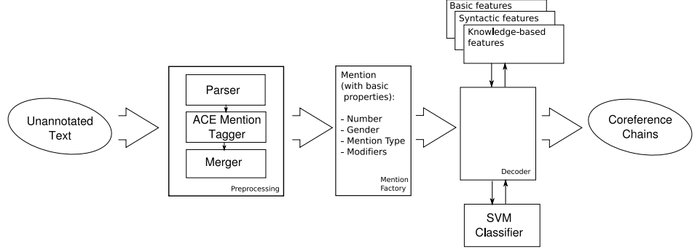2008 BARTAModularToolkitforCoreferen
- (Versley et al., 2008) ⇒ Yannick Versley, Simone Paolo Ponzetto, Massimo Poesio, Vladimir Eidelman, Alan Jern, Jason Smith, Xiaofeng Yang, and Alessandro Moschitti. (2008). “BART: A Modular Toolkit for Coreference Resolution.” In: Proceedings of the 46th Annual Meeting of the Association for Computational Linguistics on Human Language Technologies: Demo Session.
Subject Headings: Coreference Resolution System, BART Coreference System.
Notes
Cited By
- http://scholar.google.com/scholar?q=%222008%22+BART%3A+A+Modular+Toolkit+for+Coreference+Resolution
- http://dl.acm.org/citation.cfm?id=1564144.1564147&preflayout=flat#citedby
Quotes
Abstract
Developing a full coreference system able to run all the way from raw text to semantic interpretation is a considerable engineering effort, yet there is very limited availability of off-the shelf tools for researchers whose interests are not in coreference, or for researchers who want to concentrate on a specific aspect of the problem. We present BART, a highly modular toolkit for developing coreference applications. In the Johns Hopkins workshop on using lexical and encyclopedic knowledge for entity disambiguation, the toolkit was used to extend a reimplementation of the Soon et al. (2001) proposal with a variety of additional syntactic and knowledge-based features, and experiment with alternative resolution processes, preprocessing tools, and classifiers.
1 Introduction
Coreference resolution refers to the task of identifying noun phrases that refer to the same extralinguistic entity in a text. Using coreference information has been shown to be beneficial in a number of other tasks, including information extraction (McCarthy and Lehnert, 1995), question answering (Morton, 2000) and summarization (Steinberger et al., 2007) …
A number of systems that perform coreference resolution are publicly available, such as GUITAR (Steinberger et al., 2007), which handles the full coreference task, and JAVARAP (Qiu et al., 2004), which only resolves pronouns. However, literature on coreference resolution, if providing a baseline, usually uses the algorithm and feature set of Soon et al. (2001) for this purpose.
Using the built-in maximum entropy learner with feature combination, BART reaches 65.8% F-measure on MUC6 and 62.9% F-measure on MUC7 using Soon et al.’s features, outperforming JAVARAP on pronoun resolution, as well as the Soon et al. reimplementation of Uryupina (2006) …
2 System Architecture
Using the built-in maximum entropy learner with feature combination, BART reaches 65.8% F-measure on MUC6 and 62.9% F-measure on MUC7 using Soon et al.’s features, outperforming JAVARAP on pronoun resolution, as well as the Soon et al. reimplementation of Uryupina (2006). Using a specialized tagger for ACE mentions and an extended feature set including syntactic features (e.g. using tree kernels to represent the syntactic relation between anaphor and antecedent, cf. Yang et al. 2006), as well as features based on knowledge extracted from Wikipedia (cf. Ponzetto and Smith, in preparation), BART reaches state-of-the-art results on ACE-2 …
The BART toolkit has been developed as a tool to explore the integration of knowledge-rich features into a coreference system at the Johns Hopkins Summer Workshop 2007. It is based on code and ideas from the system of Ponzetto and Strube (2006), but also includes some ideas from GUITAR (Steinberger et al., 2007) and other coreference systems (Versley, 2006; Yang et al., 2006)[1]...

Figure 2: Example system configuration
Figures
References
;
| Author | volume | Date Value | title | type | journal | titleUrl | doi | note | year | |
|---|---|---|---|---|---|---|---|---|---|---|
| 2008 BARTAModularToolkitforCoreferen | Simone P. Ponzetto Alessandro Moschitti Xiaofeng Yang Massimo Poesio Jason Smith Yannick Versley Vladimir Eidelman Alan Jern | BART: A Modular Toolkit for Coreference Resolution | 2008 |
- ↑ An open source version of BART is available from http://www.sfs.uni-tuebingen.de/˜versley/BART/.
